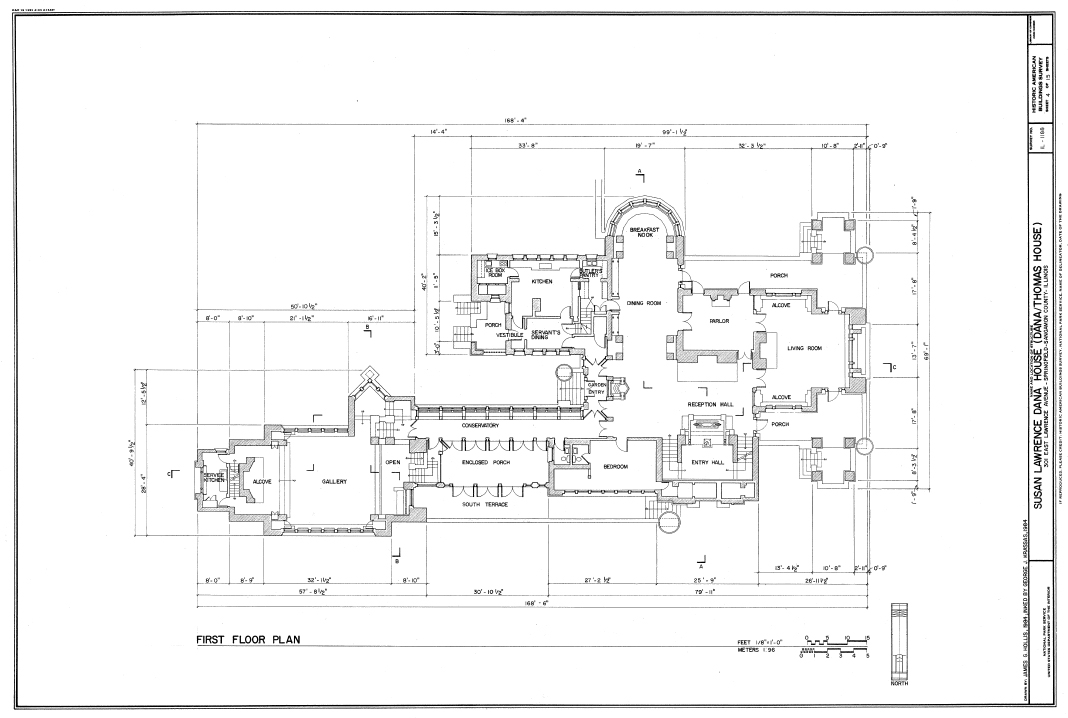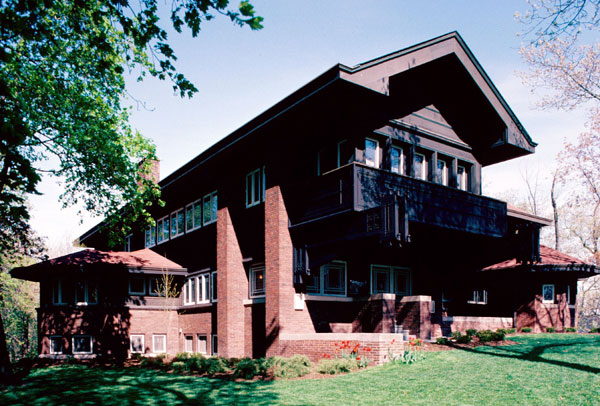|
George Mann Niedecken
George Mann Niedecken (August 16, 1878 – November 3, 1945) was an American prairie style furniture designer and interior architect from Milwaukee, Wisconsin. He is best known for his collaboration with the architect Frank Lloyd Wright. He also designed interiors for Marion Mahony Griffin who was one of the first female architects. Early life Niedecken was born August 16, 1878, in Milwaukee. At twelve years old he attended the Wisconsin Art Institute, and he studied under artist Richard Lorenz. When he was 19 he moved to Chicago and entered the Art Institute of Chicago. There he was instructed by Louis Millet. From 1899–1902 he studied art in Europe. In 1902 he returned to Milwaukee, Wisconsin where he took a position teaching decorative arts at the Wisconsin School of Arts. Niedecken married Mary (née) Thayer on October 2, 1905, and their only child died shortly after birth. Career Niedecken started an interior-architecture firm in 1907, called Niedecken-Waldbridge, wi ... [...More Info...] [...Related Items...] OR: [Wikipedia] [Google] [Baidu] |
Milwaukee, Wisconsin
Milwaukee ( ), officially the City of Milwaukee, is both the most populous and most densely populated city in the U.S. state of Wisconsin and the county seat of Milwaukee County, Wisconsin, Milwaukee County. With a population of 577,222 at the 2020 United States census, 2020 census, Milwaukee is the List of United States cities by population, 31st largest city in the United States, the fifth-largest city in the Midwestern United States, and the second largest city on Lake Michigan's shore behind Chicago. It is the main cultural and economic center of the Milwaukee metropolitan area, the fourth-most densely populated metropolitan area in the Midwestern United States, Midwest. Milwaukee is considered a global city, categorized as "Gamma minus" by the Globalization and World Cities Research Network, with a regional List of U.S. metropolitan areas by GDP, GDP of over $102 billion in 2020. Today, Milwaukee is one of the most ethnicity, ethnically and Cultural diversity, cult ... [...More Info...] [...Related Items...] OR: [Wikipedia] [Google] [Baidu] |
Dana–Thomas House
The Dana–Thomas House (also known as the Susan Lawrence Dana House and Dana House) is a home in Prairie School style designed by architect Frank Lloyd Wright. Built 1902–04 for patron Susan Lawrence Dana, it is located along East Lawrence Avenue in Springfield, Illinois. The home reflects the mutual affection of the patron and the architect for organic architecture, the relatively flat landscape of the U.S. state of Illinois, and the Japanese aesthetic as expressed in Japonism, Japanese prints. Susan Lawrence Dana Susan Lawrence Dana (1862–1946) was an independent-minded woman and heiress to a substantial fortune, including silver mines in the Rocky Mountains. Widowed in 1900, Dana enjoyed complete control over her household and fortune. Eager to express her personality and become a leading philanthropic figure in Springfield, Dana decided to completely remodel her family's Italianate mansion located in the state capital's fashionable "Aristocracy Hill" neighborhood. ... [...More Info...] [...Related Items...] OR: [Wikipedia] [Google] [Baidu] |
Prairie School Architecture
Prairie School is a late 19th- and early 20th-century architectural style, most common in the Midwestern United States. The style is usually marked by horizontal lines, flat or hipped roofs with broad overhanging eaves, windows grouped in horizontal bands, integration with the landscape, solid construction, craftsmanship, and discipline in the use of ornament. Horizontal lines were thought to evoke and relate to the wide, flat, treeless expanses of America's native prairie landscape. The Prairie School was an attempt at developing an indigenous North American style of architecture in sympathys with the ideals and design aesthetics of the Arts and Crafts Movement, with which it shared an embrace of handcrafting and craftsman guilds as an antidote to the dehumanizing effects of mass production. History The Prairie School developed in sympathy with the ideals and design aesthetics of the Arts and Crafts Movement begun in the late 19th century in England by John Ruskin, W ... [...More Info...] [...Related Items...] OR: [Wikipedia] [Google] [Baidu] |
Artists From Wisconsin
An artist is a person engaged in an activity related to creating art, practicing the arts, or demonstrating an art. The common usage in both everyday speech and academic discourse refers to a practitioner in the visual arts only. However, the term is also often used in the entertainment business, especially in a business context, for musicians and other performers (although less often for actors). "Artiste" (French for artist) is a variant used in English in this context, but this use has become rare. Use of the term "artist" to describe writers is valid, but less common, and mostly restricted to contexts like used in criticism. Dictionary definitions The ''Oxford English Dictionary'' defines the older broad meanings of the term "artist": * A learned person or Master of Arts. * One who pursues a practical science, traditionally medicine, astrology, alchemy, chemistry. * A follower of a pursuit in which skill comes by study or practice. * A follower of a manual art, such a ... [...More Info...] [...Related Items...] OR: [Wikipedia] [Google] [Baidu] |
Architects From Milwaukee
An architect is a person who plans, designs and oversees the construction of buildings. To practice architecture means to provide services in connection with the design of buildings and the space within the site surrounding the buildings that have human occupancy or use as their principal purpose. Etymologically, the term architect derives from the Latin ''architectus'', which derives from the Greek (''arkhi-'', chief + ''tekton'', builder), i.e., chief builder. The professional requirements for architects vary from place to place. An architect's decisions affect public safety, and thus the architect must undergo specialized training consisting of advanced education and a ''practicum'' (or internship) for practical experience to earn a license to practice architecture. Practical, technical, and academic requirements for becoming an architect vary by jurisdiction, though the formal study of architecture in academic institutions has played a pivotal role in the development of the ... [...More Info...] [...Related Items...] OR: [Wikipedia] [Google] [Baidu] |
1945 Deaths
1945 marked the end of World War II and the fall of Nazi Germany and the Empire of Japan. It is also the only year in which Nuclear weapon, nuclear weapons Atomic bombings of Hiroshima and Nagasaki, have been used in combat. Events Below, the events of World War II have the "WWII" prefix. January * January 1 – WWII: ** Nazi Germany, Germany begins Operation Bodenplatte, an attempt by the ''Luftwaffe'' to cripple Allies of World War II, Allied air forces in the Low Countries. ** Chenogne massacre: German prisoners are allegedly killed by American forces near the village of Chenogne, Belgium. * January 6 – WWII: A German offensive recaptures Esztergom, Kingdom of Hungary (1920–1946), Hungary from the Russians. * January 12 – WWII: The Soviet Union begins the Vistula–Oder Offensive in Eastern Europe, against the German Army (Wehrmacht), German Army. * January 13 – WWII: The Soviet Union begins the East Prussian Offensive, to eliminate German forces in East Pruss ... [...More Info...] [...Related Items...] OR: [Wikipedia] [Google] [Baidu] |
1878 Births
Events January–March * January 5 – Russo-Turkish War – Battle of Shipka Pass IV: Russian and Bulgarian forces defeat the Ottoman Empire. * January 9 – Umberto I becomes King of Italy. * January 17 – Battle of Philippopolis: Russian troops defeat the Turks. * January 23 – Benjamin Disraeli orders the British fleet to the Dardanelles. * January 24 – Russian revolutionary Vera Zasulich shoots at Fyodor Trepov, Governor of Saint Petersburg. * January 28 – ''The Yale News'' becomes the first daily college newspaper in the United States. * January 31 – Turkey agrees to an armistice at Adrianople. * February 2 – Greece declares war on the Ottoman Empire. * February 7 – Pope Pius IX dies, after a 31½ year reign (the longest definitely confirmed). * February 8 – The British fleet enters Turkish waters, and anchors off Istanbul; Russia threatens to occupy Istanbul, but does not carry out the threat. * Febru ... [...More Info...] [...Related Items...] OR: [Wikipedia] [Google] [Baidu] |
The New York Times
''The New York Times'' (''the Times'', ''NYT'', or the Gray Lady) is a daily newspaper based in New York City with a worldwide readership reported in 2020 to comprise a declining 840,000 paid print subscribers, and a growing 6 million paid digital subscribers. It also is a producer of popular podcasts such as '' The Daily''. Founded in 1851 by Henry Jarvis Raymond and George Jones, it was initially published by Raymond, Jones & Company. The ''Times'' has won 132 Pulitzer Prizes, the most of any newspaper, and has long been regarded as a national " newspaper of record". For print it is ranked 18th in the world by circulation and 3rd in the U.S. The paper is owned by the New York Times Company, which is publicly traded. It has been governed by the Sulzberger family since 1896, through a dual-class share structure after its shares became publicly traded. A. G. Sulzberger, the paper's publisher and the company's chairman, is the fifth generation of the family to head the pa ... [...More Info...] [...Related Items...] OR: [Wikipedia] [Google] [Baidu] |
Prairie School
Prairie School is a late 19th- and early 20th-century architectural style, most common in the Midwestern United States. The style is usually marked by horizontal lines, flat or hipped roofs with broad overhanging eaves, windows grouped in horizontal bands, integration with the landscape, solid construction, craftsmanship, and discipline in the use of ornament. Horizontal lines were thought to evoke and relate to the wide, flat, treeless expanses of America's native prairie landscape. The Prairie School was an attempt at developing an indigenous North American style of architecture in sympathys with the ideals and design aesthetics of the Arts and Crafts Movement, with which it shared an embrace of handcrafting and craftsman guilds as an antidote to the dehumanizing effects of mass production. History The Prairie School developed in sympathy with the ideals and design aesthetics of the Arts and Crafts Movement begun in the late 19th century in England by John Ruskin, W ... [...More Info...] [...Related Items...] OR: [Wikipedia] [Google] [Baidu] |
Frederick Robie House
The Frederick C. Robie House is a U.S. National Historic Landmark now on the campus of the University of Chicago in the South Side neighborhood of Hyde Park in Chicago, Illinois. Built between 1909 and 1910, the building was designed as a single family home by architect Frank Lloyd Wright. It is considered perhaps the finest example of Prairie School, the first architectural style considered uniquely American. Robie House was designated a National Historic Landmark on November 27, 1963, and was on the first National Register of Historic Places list of October 15, 1966. The house and a selection of seven other properties by Wright were inscribed on the World Heritage List under the title "The 20th-Century Architecture of Frank Lloyd Wright" in July 2019. History Wright designed the Robie House in his studio in Oak Park, Illinois between 1908 and 1909. The design precedent for the Robie House was the Ferdinand F. Tomek House in Riverside, Illinois, designed by Wright i ... [...More Info...] [...Related Items...] OR: [Wikipedia] [Google] [Baidu] |
Avery Coonley House
The Avery Coonley House, also known as the Coonley House or Coonley Estate was designed by architect Frank Lloyd Wright. Constructed 1908–12, this is a residential estate of several buildings built on the banks of the Des Plaines River in Riverside, Illinois, a suburb of Chicago. It is itself a National Historic Landmark and is included in another National Historic Landmark, the Riverside Historic District. History The Avery Coonley House (built 1908–12) in Riverside, Illinois, is located on a unique small peninsula surrounded by the Des Plaines River. Of the few estates that Frank Lloyd Wright developed, it is one of his largest and most elaborate Prairie School-homes ever built. It is one of just three multi-building prairie complexes built by the famed architect. The other two are the Dana–Thomas House and the Darwin D. Martin House complexes. The Coonley house is also the first example in Wright's work of a zoned plan. The raised second floor includes three zones: The ... [...More Info...] [...Related Items...] OR: [Wikipedia] [Google] [Baidu] |
Prairie Style
Prairie School is a late 19th- and early 20th-century architectural style, most common in the Midwestern United States. The style is usually marked by horizontal lines, flat or hip roof, hipped roofs with broad Overhang (architecture), overhanging eaves, windows grouped in horizontal bands, integration with the landscape, solid construction, craftsmanship, and discipline in the use of ornament. Horizontal lines were thought to evoke and relate to the wide, flat, treeless expanses of America's native prairie landscape. The Prairie School was an attempt at developing an indigenous North American style of architecture in sympathys with the ideals and design aesthetics of the Arts and Crafts Movement, with which it shared an embrace of handcrafting and craftsman guilds as an antidote to the dehumanizing effects of mass production. History The Prairie School developed in sympathy with the ideals and design aesthetics of the Arts and Crafts Movement begun in the late 19th cent ... [...More Info...] [...Related Items...] OR: [Wikipedia] [Google] [Baidu] |






.png)


